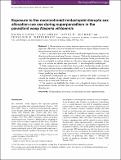Exposure to the neonicotinoid imidacloprid disrupts sex allocation cue use during superparasitism in the parasitoid wasp Nasonia vitripennis
Abstract
1. Neonicotinoid insecticides are potent neurotoxins of significant economic importance. However, it is clear that their use can adversely impact beneficial insects in the environment, even at low, sub-lethal doses. 2. It has recently been shown that the neonicotinoid imidacloprid disrupts adaptive sex allocation in the parasitoid wasp Nasonia vitripennis (Walker) by limiting their ability to respond to the presence of other females on oviposition patches. In the present study, that work was extended to explore whether sex allocation when superparasitising – laying eggs on a host that has already been parasitised – is also disrupted by imidacloprid. 3. Under superparasitism, sex allocation theory predicts that females should vary their offspring sex ratio in relation to their relative clutch size. It was found that sex allocation under superparasitism in Nasonia is disrupted in a dose-dependent manner, with exposed females producing more daughters. 4. Importantly, imidacloprid does not appear to influence the ability of females to estimate the number of eggs already present on a host, suggesting a disassociation between the sex ratio and clutch size cues. 5. The present work highlights the fitness costs to beneficial insects of exposure to neonicotinoids, but also provides clues as to how female Nasonia use information when allocating sex.
Citation
Cook , N , Green , J , Shuker , D M & Whitehorn , P R 2016 , ' Exposure to the neonicotinoid imidacloprid disrupts sex allocation cue use during superparasitism in the parasitoid wasp Nasonia vitripennis ' , Ecological Entomology , vol. 41 , no. 6 , pp. 693-697 . https://doi.org/10.1111/een.12344
Publication
Ecological Entomology
Status
Peer reviewed
ISSN
0307-6946Type
Journal article
Description
N.C., J.G., and D.M.S. were funded by Natural Environment Research Council (NERC) grant (NE/J024481/1). P.R.W. was funded by a University of Stirling Impact Fellowship.Collections
Items in the St Andrews Research Repository are protected by copyright, with all rights reserved, unless otherwise indicated.

